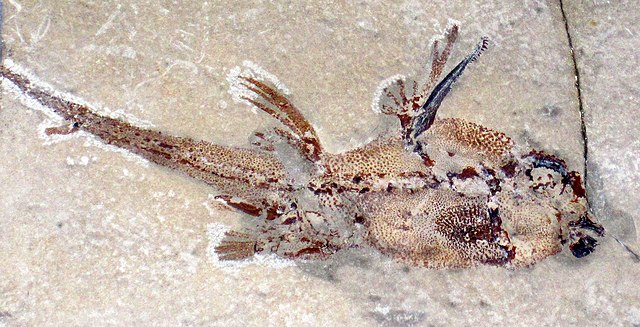The Bear Gulch Limestone is a limestone-rich geological lens in central Montana, renowned for the quality of its late Mississippian-aged fossils. It is exposed over a number of outcrops northeast of the Big Snowy Mountains, and is often considered a component of the more widespread Heath Formation. The Bear Gulch Limestone reconstructs a diverse, though isolated, marine ecosystem which developed near the end of the Serpukhovian age. It is a lagerstätte, a particular type of rock unit with exceptional fossil preservation of both articulated skeletons and soft tissues. Bear Gulch fossils include a variety of fish, invertebrates, and algae occupying a number of different habitats within a preserved shallow bay.
Echinochimaera meltoni, one of many unusual chondrichthyans found in the Bear Gulch Limestone
Belantsea montana
Echinochimaera meltoni
Falcatus falcatus
Squatinactis is a genus of extinct elasmobranch chondrichthyan known from the Carboniferous aged Bear Gulch Limestone in Montana. This fish was discovered in 1974 by Richard Lund. The type specimen, named CMNH 46133, consists of a brain case, poorly preserved jaws and gills, a pectoral fin, and a partial vertebral axis. This creatures most startling feature were its broad pectoral fins which resembled those of stingrays and angel sharks (Squatina). The holotype specimen has about 15 teeth in its jaw. This creature is named after the angel shark. Remains found in the South Urals of Russia and the Eyam Limestone of Derbyshire, England, have been tentatively identified as those belonging to S. caudispinatus.
Squatinactis





